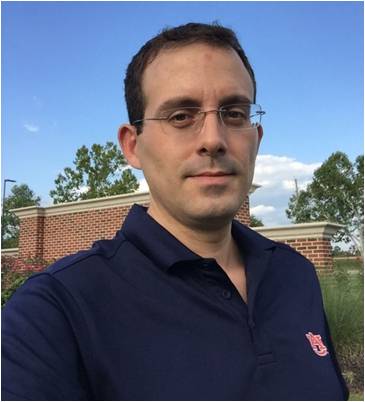content body

Evangelos Miliordos, James E. Land Associate Professor in Auburn’s Department of Chemistry and Biochemistry, helped explain how urea can form spontaneously inside saltwater droplets.
A chance discovery inside a microscopic droplet is reshaping what scientists know about one of the world’s most important chemicals, and faculty in Auburn’s College of Sciences and Mathematics played a key role in explaining why.
When researchers at ETH Zurich, a top science and technology university in Switzerland, observed urea forming spontaneously inside saltwater aerosols — with no added heat or pressure — they turned to Auburn’s Evangelos Miliordos, the James E. Land Associate Professor of Chemistry and Biochemistry, for answers. What Miliordos and his collaborators found could change how urea is produced and even how we think life first began on Earth.
The findings, published in the prestigious journal Science, reveal how urea can form under conditions far milder than those used in current industrial processes. That discovery, Miliordos said, was not just surprising. It may also have implications for more sustainable manufacturing and our understanding of early Earth chemistry.
“Urea is a big part of the global economy,” said Miliordos, a computational chemist in Auburn’s Department of Chemistry and Biochemistry. “It’s made in large quantities because it’s the starting material for fertilizer, but making it is energy intensive. We wanted to understand how to make it in a low-energy way.”
In Zurich, researchers accidentally stumbled on something unexpected. While conducting an unrelated experiment, they sprayed tiny droplets of salt water into a chamber filled with carbon dioxide and ammonia gas — two ingredients used to make urea. To their surprise, urea began forming on its own inside the droplets.
“They didn’t use high temperatures or pressure, no added energy, and yet urea appeared,” Miliordos said. “Our contribution was to explain why.”
What his team uncovered is a remarkable example of how chemical behavior can change depending on the environment. In traditional solutions, acids and bases cancel each other out. But within a droplet, the story is different.
“When you have a sphere like a droplet, the concentration of molecules isn’t uniform,” Miliordos said. “It varies with distance from the center. In one region of the droplet, you might have a basic environment, which is good for the first step of the reaction. Then farther out, an acidic environment for the next step.”
That layered structure inside droplets seems to create the perfect setting for urea to form naturally. The salt in the water — sodium chloride — helps stabilize the droplets, allowing those conditions to remain intact long enough for the chemical reaction to occur.
Miliordos said this insight opens an entire area of research known as droplet chemistry. It may even offer a glimpse into Earth’s distant past.
“Think about early Earth,” he said. “There was seawater, waves, carbon dioxide and ammonia in the atmosphere. The first urea molecules may have formed just like this, inside droplets made by ocean spray. That could help explain how more complex organic molecules, even amino acids, first emerged.”
The computational work was key to understanding how urea formation could bypass the high-energy requirements of industrial methods. While this study focused on urea, Miliordos hopes the findings can extend to other chemical reactions.
“The big picture now is: Can we use this droplet approach for other reactions that need both acidic and basic conditions?” he said. “We’ll keep working on that.”
This paper marks Miliordos’ second Science publication with the Swiss research team, led by Professor Ruth Signorell at ETH Zurich.
“I’m really blessed and grateful to my collaborators and to Auburn for supporting this work,” he said. “It’s exciting to be part of something that could have both industrial and fundamental impact.”





